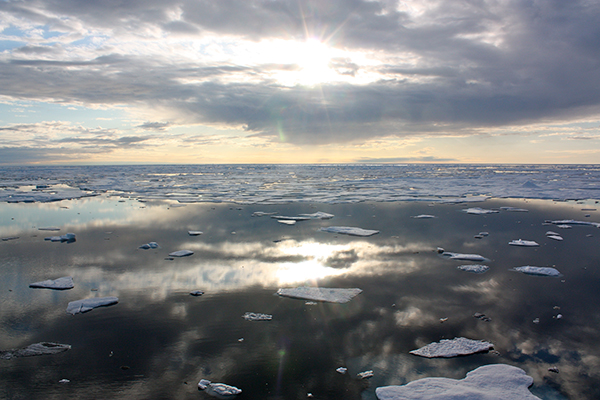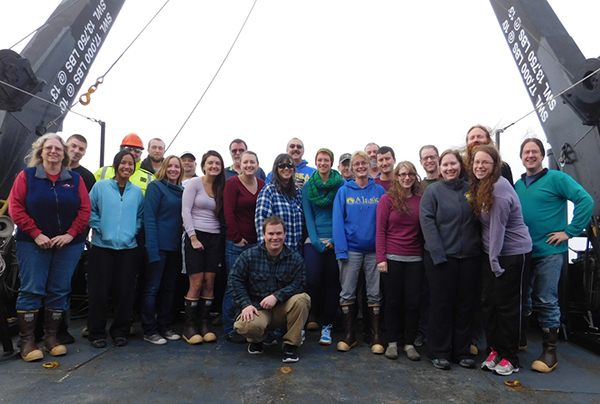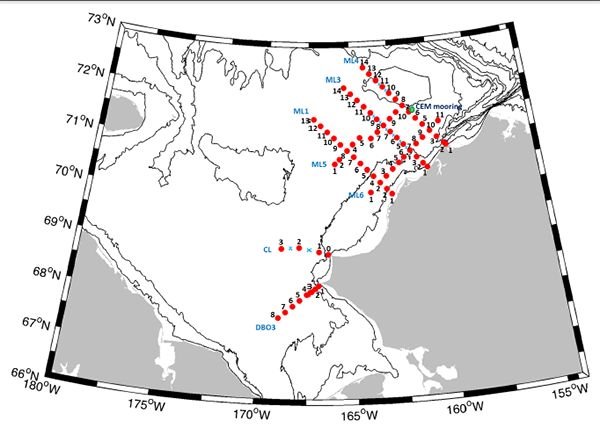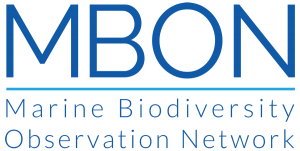
Sea Ice on the Chukchi Sea. Photo Credit: NASA/Kathryn Hansen
In August 2015, the Arctic Marine Biodiversity Observing Network (AMBON) set out for their first field cruise. Led by chief scientist Katrin Iken (University of Alaska Fairbanks), the team of researchers from the University of Alaska's School of Fisheries and Ocean Sciences, the University of Maryland, University of Washington, US Fish and Wildlife Service, and NOAA departed for a month-long trip to sample marine biodiversity on the Chukchi Sea shelf.

Researchers aboard the Norsemen II in the Chukchi Sea. Photo Credit: Katrin Iken
Marine biodiversity is a key indicator of ocean health and critical ecosystem services that contribute to human life. Monitoring biodiversity and building an integrated picture over improves our ability to forecast and respond to potential threats. The unprecedented effects of climate change combined with strong seasonal cycles and increasing human activities in the Arctic make this region particularly important to monitor.

Station map of the AMBON 2015 cruise. Red dots indicate full stations, blue X indicates CTD stations only, green circle indicates CEM mooring.
Despite challenging weather conditions, the team was able to complete sampling of the entire Chukchi shelf from south to north and across the shelf from nearshore to 250 km (150 miles) offshore. Key findings from Year 1 on the water column, the sea floor, marine mammals and seabirds include:
- Water column:
- Physical measurements of the water column established warmer waters flowing northward along the Alaskan coast, associated with the Alaska Coastal Current, although researchers did not observe the expected corresponding low salinity of this water mass.
- Water column chlorophyll was particularly high in the southern and northern offshore study regions, with lesser concentration in the middle region. These chlorophyll water column patterns were reflected in sediment chlorophyll, confirming the tight relationship between the pelagic and the benthic systems from sinking of phytoplankton production to the seafloor.
- Seafloor:
- They observed strong gradients in biomass and diversity of epifauna invertebrates. Both biomass and species richness were much higher in the northern than the southern Chukchi Sea, indicating a very relaxed relationship of the epifauna with chlorophyll, which is commonly used as a measure of food availability. This is different from known patterns in macro-infaunal patterns, organisms living buried within the sediment such as clams and tube worms, which are very strongly tied to chlorophyll distribution. For example, sediment chlorophyll values peak in regions that also are known as macro-infauna hotspots in the southern Chukchi Sea.
- Bottom fish were generally small in size but at times very abundant, and bottom fish and epibenthic invertebrates showed some overlap in distribution patterns.
- The AMBON cruise was extremely successful in collecting approximately 80% of the expected species diversity of epifauna (about 290 of an expected approximately 350 species) and nearly 100% of expected richness of bottom fish (28 of approximately 32 expected species), reflecting the success of the sampling design used in the project for monitoring these ecosystem components.
- Marine mammals:
- Pacific walrus in particular were most common in the northern study region, in part coinciding with high biomass of benthic invertebrates that serve as food sources for these bottom-feeding mammals.
- As sea ice in the Chukchi Sea is more and more diminished, walrus cannot use it any longer as a resting platform between feeding bouts; they have become more tied to the land for haul-out, and thus to the benthic food resources closer to shore.
- The ecosystem-wide sampling from AMBON provides an unprecedented high coverage dataset to study the associations between walrus and their food resources under these new ice-free scenarios.
- Seabirds:
- A variety of seabirds, including some common species such as phalaropes and shearwaters and some rare species such as dovekies, occurred during the AMBON cruise, with highest overall densities in the most southern and the most northern regions. Shearwaters feed on fish and zooplankton and forage both at the surface and underwater, and were most abundant near Barrow Canyon. Barrow Canyon is an area where physical processes concentrate prey in the water column, attracting an abundance of marine birds and mammals.
- Similarly, surface-feeding marine birds that include gulls, terns, and phalaropes, were concentrated around Barrow Canyon, close to Pt. Barrow. Least auklets and murres were abundant in areas of strong currents and high productivity, while benthic-feeding marine birds, such as eiders, occurred primarily near shore.

Researchers sort through samples from the trawl. Photo Credit: Katrin Iken
AMBON is a joint initiative taking place under the National Oceanographic Partnership Program (NOPP) with support from the Bureau of Ocean Energy Management (BOEM), the National Oceanic and Atmospheric Administration (NOAA) and industry (Shell Oil Company). This project, along with similar efforts in the Florida Keys and Monterey Bay and the Santa Barbara Channel in California, is one of three U.S. demonstration projects helping to develop a Marine Biodiversity Observing Network (MBON) for the nation. It aims to develop good practices for a biodiversity network that can be translated to other regions and ecosystems. Beyond the Chukchi Sea, and will network across the pan-Arctic and on a global scale with other biodiversity observing networks. The project also will integrate with past and ongoing research programs on the U.S. Arctic shelf to develop an Arctic biodiversity observation network of shared information and open data access. The study is expected to run until 2019. Future research will include data collection from NASA and NOAA satellites.

 Official websites use .gov
A .gov website belongs to an official government organization in the United States.
Official websites use .gov
A .gov website belongs to an official government organization in the United States.
 Secure .gov websites use HTTPS
A lock or https:// means you’ve safely connected to the .gov website. Share sensitive information only on official, secure websites.
Secure .gov websites use HTTPS
A lock or https:// means you’ve safely connected to the .gov website. Share sensitive information only on official, secure websites.
